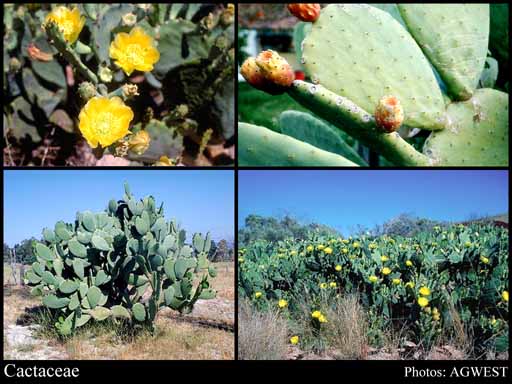- Reference
- Gen.Pl. [Jussieu] 310 (1789)
- Name Status
- Current

Scientific Description
Common name. Cactus Family.
Habit and leaf form. Shrubs, or herbs; when present and identifiable as such, deciduous (often caducous); non-laticiferous and without coloured juice (usually), or laticiferous (rarely). ‘Normal’ plants (more or less, Pereskieae), or switch-plants, or plants of very peculiar form (usually more or less spiny, with clusters of spines in hairy, spiralled areoles); ‘cactoid’ (usually), or with the principal photosynthesizing function transferred to stems (sometimes with cylindrical-ridged stems, sometimes with cladodes). Leaves well developed (Pereskieae), or much reduced to absent (mostly). Plants succulent (mostly), or non-succulent (Pereskieae, with only ‘more or less fleshy’ leaves). Perennial. Self supporting, or epiphytic, or climbing. Pachycaul. Xerophytic. Leaves when present, alternate; spiral; ‘herbaceous’, or fleshy, or membranous (usually small and ephemeral); petiolate to sessile; non-sheathing; simple. Leaf blades entire; one-veined, or pinnately veined; cross-venulate, or without cross-venules. Stem anatomy. Nodes when recorded, unilacunar (with one trace, this often bi- or multi-fid). Secondary thickening developing from a conventional cambial ring.
Reproductive type, pollination. Fertile flowers hermaphrodite. Unisexual flowers absent. Plants hermaphrodite (usually). Anemophilous, or entomophilous, or ornithophilous, or cheiropterophilous.
Inflorescence and flower features. Flowers solitary, or aggregated in ‘inflorescences’; in cymes. The terminal inflorescence unit (when flowers aggregated) cymose. Flowers medium-sized to large (often showy); fragrant (often), or odourless; regular to somewhat irregular. The floral asymmetry (when noticeable) involving the perianth, or involving the perianth and involving the androecium. Flowers partially acyclic. The perianth acyclic, or the perianth acyclic and the androecium acyclic. Free hypanthium present, or absent. Perianth sequentially intergrading from sepals to petals, or petaline; 20–100 (‘many’); free, or joined (basally); green and white, or cream, or yellow, or orange, or red, or pink, or purple. Corolla if the perianth so interpreted, 20–100 (‘many’); green and white, or cream, or yellow, or orange, or red, or pink, or purple. Androecium 15–100 (‘many’). Androecial members branched, or unbranched; maturing centrifugally; free of the perianth (occasionally), or adnate (to perianth tube); free of one another, or coherent (sometimes in groups). Androecium exclusively of fertile stamens. Stamens 15–100 (‘many’). Anthers dehiscing via longitudinal slits; introrse; bilocular; tetrasporangiate. Gynoecium 3–100 carpelled (to ‘many’). The pistil 1 celled. Gynoecium syncarpous; synstylovarious; inferior (nearly always), or superior (Pereskia). Ovary unilocular; 1 locular (but partially partitioned in Pereskia). Epigynous disk present (within the hypanthium). Gynoecium stylate. Styles 1; apical. Stigmas 3–100 (as many as G); wet type; non-papillate; Group IV type. Placentation parietal (usually), or basal (Pereskia). Ovules in the single cavity 15–100 (‘many’); long funicled; arillate, or non-arillate; circinotropous, campylotropous (usually), or anatropous.
Fruit and seed features. Fruit fleshy (usually), or non-fleshy; indehiscent (usually), or dehiscent (rarely); a capsule (rarely), or a berry (usually). Seeds non-endospermic. Perisperm present, or absent. Seeds winged, or wingless; with starch. Embryo rudimentary at the time of seed release to well differentiated. Cotyledons 2 (when differentiated). Embryo achlorophyllous (4/5); straight, or curved (usually). Seedling. Germination phanerocotylar.
Physiology, biochemistry. Photosynthetic pathway: CAM (nearly always), or C3 (dubiously?).
Geography, cytology, number of species. World distribution: chiefly in the drier regions of tropical America, but reaching Patagonia and ascending to the High Andes; only Rhipsalis (perhaps introduced) in Africa, Madagascar, Mauritius, Seychelles and Ceylon. X = 11. 2000 species.
Economic uses, etc. Some edible fruits (prickly pear, India fig, tuna, arridari, pitaya).